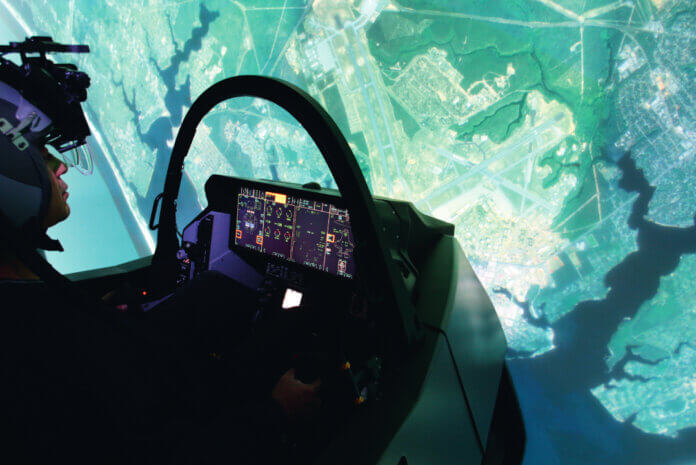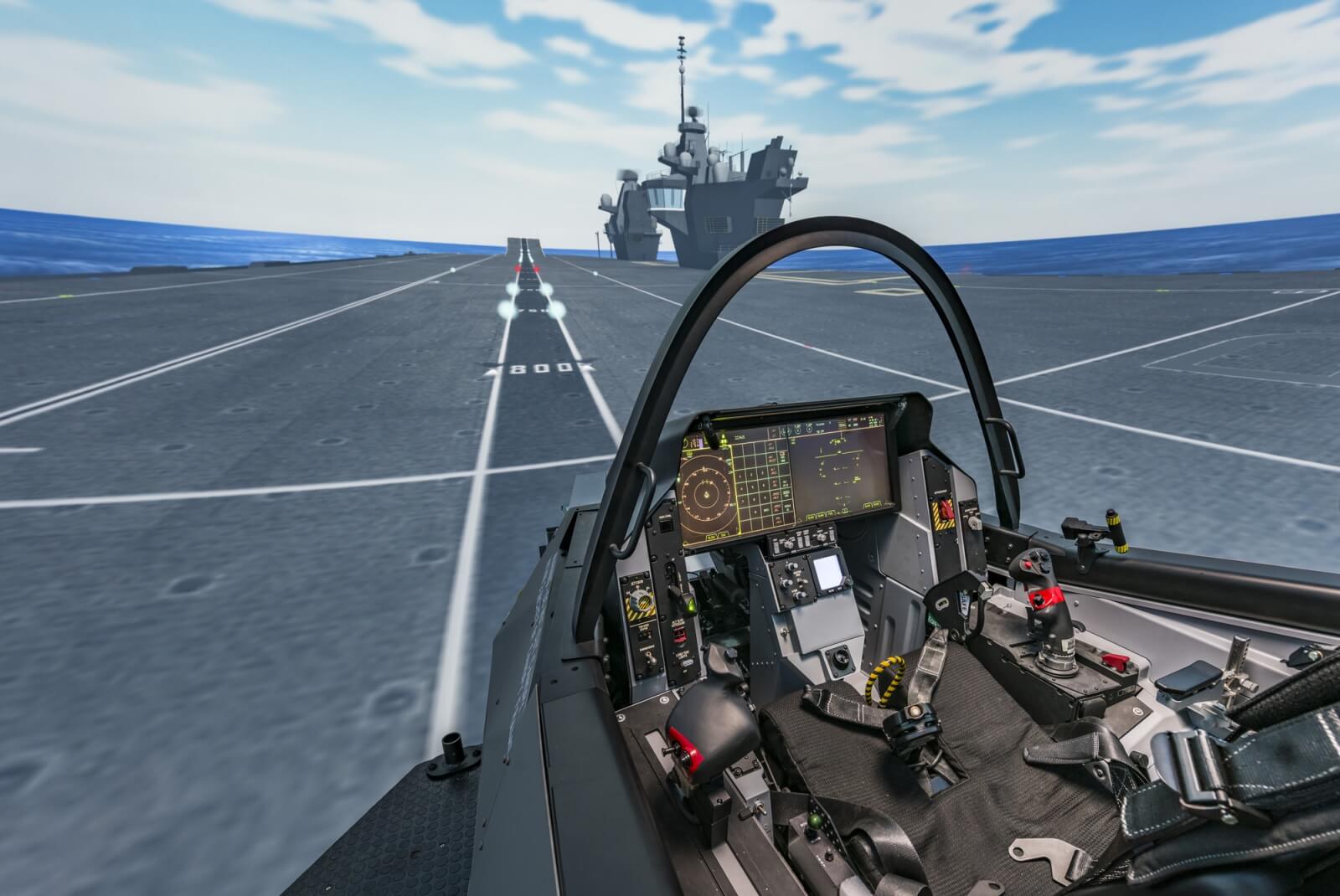
While there seems to be a general agreement that more synthetic flying is a good thing (cost-effective, environmentally better, and broadly more inclusive), will it ultimately result in better, more confident and motivated pilots.
Military flying training is already heavily reliant on the use of simulators, operating in the so-called synthetic environment. The Eurofighter Typhoon’s synthetic environment has already allowed the Royal Air Force (RAF) to achieve a synthetic training-to-live flying ratio of close to 50:50, and No.617 Squadron is achieving a similar ratio for operational Lockheed Martin F-35 training. But a number of senior officers in the RAF (and in other air arms) are ‘betting the farm’ on dramatically extending the scope and extent of synthetic training. Air Chief Marshal Sir Mike Wigston, the Chief of the Air Staff (CAS) recently said that “I do not exaggerate when I say that I can see a future where almost all training, force generation, and mission planning and rehearsal is done in a synthetic environment, preserving our real-world activity for live operations or strategic signalling.” Others have predicted a synthetic v live ratio of as much as 90:10.
The World Is Not Enough
Today’s air domain is becoming increasingly contested and information-dominated, with a rapidly evolving and ever more complex threat environment. A potential peer-level or near-peer clash is becoming increasingly difficult to train for using traditional methods. It is hard to amass the size of force that might be engaged, and harder yet to adequately emulate a realistic peer-level threat, even given adequate funding. But more importantly, even the most life-like exercises (such as Red Flag) cannot allow participants to use their sensors and simulated weapons to their maximum potential, if they are to avoid compromising tactics and exposing weapons’ performance parametrics to enemies who are always watching. If simulated in the real world, a realistic MBDA Meteor BVRAAM shot will give those enemies useful data and could allow them to develop better tactics and countermeasures. No-one wants to fly their F-35s in full-up ‘go to war’ configuration and risk an enemy learning at exactly what range ‘fighter X’, or ‘SAM guidance radar Z’ can detect them, or lock on to them.

The synthetic environment, using a complex ‘grid’ of networked simulators offers a solution to conducting this kind of realistic operational training, though it has limitations. Even when ultra-realistic and highly immersive, many pilots feel that synthetic training never feels like the real thing – that dangerous scenarios never feel risky, and that dropping a weapon (for example) never presents the same brief ‘pause for thought’. Moreover, to be really useful, the synthetic environment has to encompass the fast jet combat air platforms, but also the enablers and force multipliers. This is the thinking behind the RAF’s new Gladiator distributed flight simulation system which will be linked to the NEXUS combat cloud. Gladiator is intended to have an initial operational capability by the end of 2021, and will include Typhoon and other RAF and UK platforms including the Type 45 destroyer, the Boeing E-7A Wedgetail, and even the unmanned General Atomics (GA-ASI) MQ-9B Protector, allowing large scale virtual training to take place.
The RAF’s F-35 Lightning force uses a Lightning Integrated Training Centre (ITC) at RAF Marham, which includes four FMS (full mission simulators) with 360 degree domes, helmet-mounted displays, and full cockpits. The simulator has been accredited by RAF test pilots to be a direct and exact representation of how the aircraft performs and handles in the air, and is said by some to be like having four extra dedicated training aircraft on the line. When embarked on the carrier, the Lightning force can take with it two deployable mission rehearsal trainers, with two cockpits in each, which can be linked together to allow a four-ship mission to be ‘flown’, just as can be undertaken in the ITC. They have the same software as the FMS, but without the full 360 degree dome.

Though the ITC’s ‘cockpits’ are networked together, data security concerns have thus far prevented them from being linked with other UK military synthetic training devices, though there is already talk of networking the ITC with USAF synthetic training devices when US Air Force F-35As become operational at nearby RAF Lakenheath.
The synthetic environment has to be secure, since otherwise it could be vulnerable to cyber attack or cyber espionage, risking the exposure of exactly the kind of highly classified mission data, weapons parametrics and tactics that the synthetic environment is intended to keep hidden from enemy eyes.
As well as being used for operational training, synthetic training is increasingly being seen as a useful tool throughout all stages or phases of pilot training, non-pilot aircrew training, and operational conversion training, and even for some maintenance training, too.
Young pilots now undergoing flying training are undertaking a much higher proportion of synthetic training compared to live flying than their predecessors did even a few years ago. The theory is that this will teach them to fly fifth-generation fighters better and will also improve their learning.
The UK is in the process of completing the introduction of the new UK Military Flying Training System (MFTS). This partnered solution between the MOD and Ascent Flying Training (a joint venture between Babcock and Lockheed Martin) is still in a state of flux, but seems certain to see a dramatic increase in the use of synthetics, as those involved seek to increase the output of trained pilots and reduce the time taken to train those aircrew.
The current fast jet training system is based on the use of three aircraft types – the Grob Aircraft G120TP Prefect for elementary training, the Beechcraft T-6C Texan for basic training, and finally the BAE Systems Hawk T.Mk 2 for advanced training. But in an effort to speed up and increase the capacity of the system, alternative approaches are being investigated.
Some pilots have gone directly from the Prefect to the Hawk, cutting out the Texan, while others have gone directly to the Texan from Officer Training, and then onto the Hawk, cutting out the Prefect. The latter route is deemed particularly suitable for those with previous flying experience from the University Air Squadrons. These changes reportedly promise to allow a reduction in training time of about 30 percent while also increasing flexibility.
The RAF pioneered the close integration of synthetic pilot training and live flying in the Hawk T.Mk 2 Advanced Flying Training element of MFTS. The Hawk T.Mk 2 is a training system rather than a simple training aircraft, using advanced simulation and digital debriefing facilities on the ground and having comprehensive sensor and weapons emulation capabilities in the air. Today, most trainers follow the same approach, and aircraft like the Boeing T-7 Red Hawk and Aermacchi M346 Master similarly form merely the airborne element within an overall training system.

Quicker Qualification
Until recently, the ground-based flying training environment has generally consisted of a mix of full mission simulators, part-task and desk-top trainers, but the advent of more immersive simulators, virtual reality, and Artificial Intelligence is changing this domain rapidly.
Virtual Reality is believed by many to offer the greatest potential for increasing the capacity of training courses and to improve the throughput of student pilots. Ascent is now trialling some CAE Sprint Virtual Reality based flight training devices for fast-jet pilot training, and it is widely expected that Virtual Reality will be used to enable informal training before students start a particular course, or when they are holding or waiting for the next stage of their flying training. This promises to speed up progress through the system once student pilots formally begin a flying course.
Changing the live-synthetic balance in favour of making greater use of synthetics promises to reduce costs, but it is recognised that careful analysis will be required in order to at least maintain, or even improve, the quality of flying training while simultaneously driving down costs. An evidence-based approach, measuring student performance across all training domains, will be needed if the customer, (the Front Line) is to retain confidence in the training system, and if he is to be reassured that essential qualities are not being lost or eroded.
In the operational conversion training space, synthetics have a particularly important part to play, not least because frontline operational aircraft types tend to be much more expensive to operate – and also have a greater environmental impact. In the UK, the conversion of pilots to the Typhoon has been dramatically shortened, with a 25:75 ratio in favour of synthetic based training over live flying training leading to a 30 percent increase in the numbers of pilots trained, and a course that takes half the time that it used to. In the process, thousands of hours of costly live flying training has been saved – which also means about 9.6 tonnes of carbon saved by every synthetic flight! This will help to reduce the current carbon footprint of live training, supporting the net zero ambitions of the UK MoD.
Some believe that the best approach is not to significantly reduce live flying, but rather to use synthetics for learning and mission rehearsal, using the live environment to confirm and validate what has been covered in the synthetic environment, getting better value from live sorties.
Tristan Crawford, the CEO of Aeralis, believes that the future of training will be highly synthetic, but that a live flying capability will remain essential in order to ensure that students get the real experience that they need. “You can imagine that if you reduce the cost burden of the live flying element, because we’ve got a modular aircraft system, you can afford to buy more of it. So you can buy back the live flying that you still need to do to keep students motivated to fly and give you all the extra capability that you need. So synthetic doesn’t mean the end of the line for the live flying, you just need to break it down differently.”
Guarding Against Over Reliance
Some believe that there may also be real downsides to reducing live flying. General Charles Q. Brown, the 22nd chief of staff of the US Air Force, has pointed out the difficulties of maintaining the ability to generate large scale operations if the peacetime flying rate is too low. An over reliance on synthetics could impact adversely on the proficiency of ground crews, maintainers, armourers, air traffic controllers and other support staff. Some even fear that the ‘real world’ accident rate could increase if pilots have inadequate live flying experience.
There are potentially even more serious implications for pilot recruiting and retention. If future fast jet pilots face spending the bulk of their time sitting in simulators and looking through VR headsets, rather than actually getting airborne, then many of them might become demotivated, and might instead opt for a career in civil aviation. If you want to be a pilot you may not be attracted by a career in which most of your flying is virtual, except in a war situation.
But that may be an old fashioned view. The iPad generation may be much more comfortable operating in the synthetic environment, and may be less attached to ‘real’ flying. Certainly, some report that younger F-35 pilots tend to feel at home in the ITC faster than more experienced pilots, and are quicker to adapt to it, and to the different ways of operating the latest generation of aircraft. In traditional aircraft, if a pilot loses situational awareness he will tend to fly the aircraft and look outside, whereas in an aircraft like the F-35, with its powerful sensors, the better answer might be to engage the autopilot and go head down to see exactly what the system is seeing.
by Jon Lake













